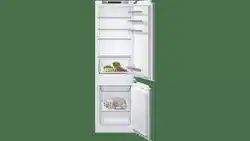Loading ...
Loading ...
Loading ...

Defrosting en
19
¡ Vegetables: Wash, chop up and
blanch before freezing.
¡ Fruit: Wash, pit and perhaps peel,
possibly add sugar or ascorbic
acid solution.
¡ Food that is suitable for freezing in-
cludes baked items, fish and sea-
food, meat, game, poultry, eggs
without shells, cheese, butter and
quark, ready meals and leftovers.
¡ Food that is unsuitable for freezing
includes lettuce, radishes, eggs in
shells, grapes, raw apples and
pears, yoghurt, sour cream, crème
fraîche and mayonnaise.
Packing frozen food
If you select suitable packaging ma-
terial and the correct type of pack-
aging, you can determine the product
quality and prevent freezer burn.
1. Place the food in the packaging.
2. Squeeze out the air.
3. Pack food airtight to prevent it
from losing flavour and drying out.
4. Label the packaging with the con-
tents and the date of freezing.
11.6 Shelf life of frozen food
at −18°C
Food Storage time
Fish, sausages, pre-
pared meals and
baked goods
up to
6months
Poultry, meat up to
8months
Vegetables, fruit up to
12months
The imprinted freezer calendar indic-
ates the maximum storage duration
in months at a constant temperature
of –18°C.
11.7 Defrosting methods for
frozen food
CAUTION
Risk of harm to health!
During the thawing process, bacteria
may multiply and spoil the frozen
food.
▶
Do not refreeze food after it has
been defrosted or started to de-
frost.
▶
Refreeze food only after cooking.
▶
These items should no longer be
stored for the maximum storage
period.
¡ Defrost animal-based food, such
as fish, meat, cheese, quark, in the
refrigerator compartment.
¡ Defrost bread at room temperat-
ure.
¡ Prepare food for immediate con-
sumption in the microwave, in the
oven or on the hob.
Defrosting
12 Defrosting
Defrosting
12.1 Defrosting in the refri-
gerator compartment
When the appliance is operating,
condensation droplets or frost form
on the rear panel of the refrigerator
compartment due to functional reas-
ons. The back panel in the refriger-
ator compartment defrosts automatic-
ally.
Condensation runs through the con-
densation channel into the drainage
hole to the evaporation pan and does
not have to be wiped away.
To ensure that the condensation can
drain and odours do not form, ob-
serve the following information:
→"Cleaning the condensation chan-
nel and drainage hole", Page21.
Loading ...
Loading ...
Loading ...
